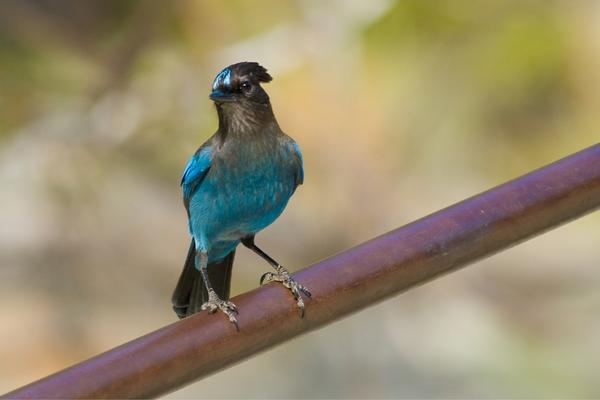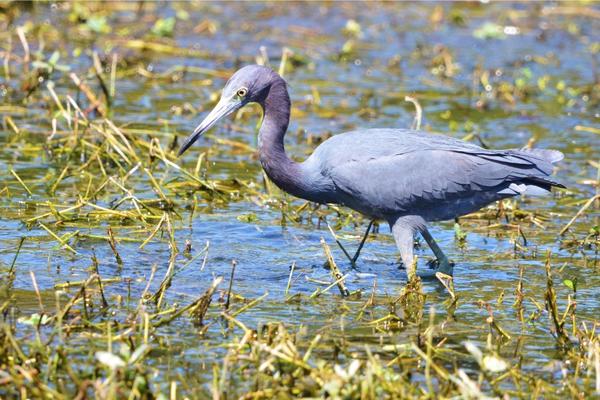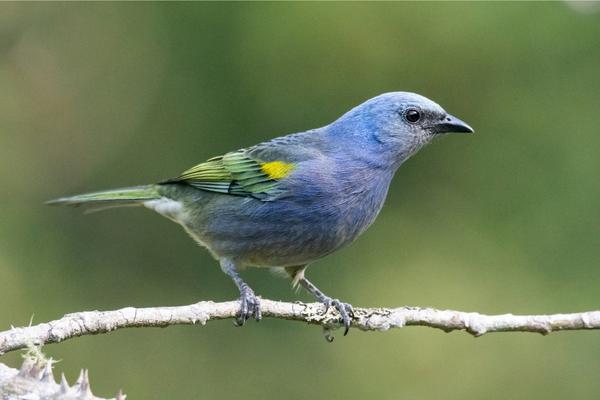Here’s 25 STUNNING blue colored birds you must see…
1. Blue Jays

Blue Jays are blue-colored birds native to North America that have bold personalities and make distinct calls. They can be found in parks, gardens, and woodlands, where they hunt for various nuts, seeds, and small insects.
Blue Jays have a wide wingspan of 11-14 inches, making them pretty impressive creatures to witness! They are incredibly adaptable birds with the ability to survive through all four seasons, adjusting their diet accordingly during colder months.
Their blue color is vibrant and prominent amongst their other feathered peers which can make them easy to spot when you’re bird-watching or on a nature hike.
2. Indigo Bunting
The indigo bunting is a medium-sized songbird native to North and Central America. The male of the species has a stunningly brilliant blue color, while the female is brown with some tinges of blue.
Males may turn brown during winter months, but they become their trademark striking blue during mating season. The bird’s song consists of a series of clear whistles, which makes it easy to identify.
They feed on insects and seeds, and can often be seen flitting around open fields in search of food.
Indigo buntings are monogamous, meaning that they form pairs for life and often return to the same nesting area each year. They create a cup-shaped nest in trees, shrubs, or sometimes even on the ground.
The female lays three to four eggs per clutch and incubates them for about two weeks. After hatching, both parents will feed the young until they are able to fend for themselves.
The indigo bunting is considered an important pollinator species due to its large range and its preference for open fields.
This bird is also a very popular choice for many backyard birders, as it can be easily attracted to feeders filled with seeds and other treats. If you are looking for a stunningly beautiful blue bird to add some color to your garden, the indigo bunting may be a perfect choice!
3. Steller’s Jay

Steller’s Jay (Cyanocitta stelleri) is a striking bird with beautiful blue and black coloring. They are found in western North America, from central Alaska to the southwestern United States and northwestern Mexico.
Steller’s Jays prefer open coniferous forests or mixed coniferous-deciduous woodlands and are often found near water.
Steller’s Jays have a loud, harsh call that is easily recognizable and can be heard for long distances. Like most jays, they are very intelligent and highly adaptable birds. They have an impressive array of vocalizations that include whistles, rattles, squawks, and more.
Steller’s Jays feed mainly on nuts, fruits, insects, and carrion. They have been known to take eggs and nestlings of smaller birds as well.
In the wild, they will often forage in flocks but are just as happy to raid bird feeders or scavenge from human waste if given the chance.
These birds are highly acrobatic, often hanging upside down or darting through trees with incredible agility. Steller’s Jays form monogamous pairs and often remain together for life.
The female builds the nest in a tree cavity, usually high off the ground, that she lines with soft materials such as mosses, animal fur, or feathers.
The brilliant blue coloring of Steller’s Jays makes them a beautiful addition to any bird-watching endeavor.
They are also fun to watch for their antics and lively behaviors, whether hanging upside down from the highest branch or boldly raiding a bird feeder. With their wide range and adaptability, these birds can easily be found in many parts of North America.
4. Tree Swallows
Tree Swallows are an incredibly popular bird among bluebirds, with their bright blue feathers and distinct white belly. These cheerful birds are found all across North America and can be spotted in a variety of habitats, including open fields, marshes, shorelines, and more.
Tree Swallows build intricate nests in tree cavities or nest boxes that they prefer to line with feathers and grass.
They feed on flying insects such as mosquitos, flies, wasps, and more. Interestingly, Tree Swallows often compete for nesting holes against other species like House Wrens and European Starlings.
Tree Swallows are social birds that can be seen in small flocks of up to 30 individuals. During mating season, they become monogamous and form pairs that stay together until the following spring.
Tree Swallows are also notable for their beautiful courtship rituals where they can be seen in aerial displays of chases and dives to show off their bright blue feathers.
5. Little Blue Heron

The little blue heron (Egretta caerulea) is a wading bird native to the Americas. It is a medium-sized heron and can be identified by its slate-blue body, white neck and head, black legs and yellow feet. Its long beak is yellow at the base with a black tip.
Little blue herons are found near wetlands, shores, and estuaries in the eastern half of North America. They can also be sighted in western Mexico and Central America. During the breeding season, they migrate to the Great Plains, northern Midwest states, and south-central Canada. Their diet consists primarily of fish, amphibians, insects, and crustaceans.
Little blue herons are solitary birds, though they may sometimes form small groups during the breeding season. These groups typically consist of a single male and several females. Little blue herons build nests in trees around wetlands and lay two to five bluish-green eggs per clutch.
In recent years, habitat loss has caused little blue herons to become increasingly rare in some parts of their ranges. As a result, the International Union for Conservation of Nature (IUCN) lists them as being near threatened.
Fortunately, conservation efforts have helped stabilize their populations and they are currently considered secure throughout much of their range.
To protect this species, it is important to continue conserving wetland habitats. Additionally, we should use safe and sustainable fishing practices, since this species relies heavily on aquatic food sources. Together, these efforts can help ensure that little blue herons remain a part of our natural world for years to come.
6. Barn Swallows
Barn swallows (Hirundo rustica) are small birds that are found across the world. They have a unique blue coloration on their heads, backs, and wings.
The underparts of these birds are white with a light brown wash. Barn swallows reach up to 5 inches in length and have forked tails which give them greater maneuverability when in flight.
These birds are aerial insectivores; they feed on flying insects, captured in midair. They have short beaks which are adapted for catching their prey while in flight.
Barn swallows build nests from mud and grasses, typically found near human dwellings such as barns or buildings. In the Northern Hemisphere, they migrate south during the winter months.
7. Mountain Bluebird

The Mountain Bluebird (Sialia currucoides) is the state bird of Idaho, Nevada, and Utah. This beautiful bluebird lives in open meadows and alpine foothills in western North America.
Its range extends from Alaska to Mexico, but it can be seen as far east as Minnesota during the summer months. This species prefers higher elevations, often nesting in the ponderosa pine forests at up to 16,000 feet.
Mountain Bluebirds are small songbirds with pale blue heads and backs, as well as white underparts and tails. The males have bright blue wings and tails that contrast sharply with the females’ more muted hues. They have slender bills and long legs, making them well-suited for catching flying insects in midair.
The diet of the Mountain Bluebird consists mainly of insects such as grasshoppers, crickets, and beetles. They also eat some seeds, berries, and small amphibians. These birds hunt by flying low over open fields and catching their prey in mid-flight.
In the summer, the Mountain Bluebird builds its nest in cavities of trees or rock crevices. The female lays four to seven eggs at a time. Both parents take turns incubating the eggs until they hatch after about two weeks.
The chicks fledge after another three weeks and are ready to be on their own within two months.
Mountain Bluebirds are social birds and can often be seen in large flocks throughout the year. They use communal roosts at night for protection from predators, as well as to conserve energy during cold weather.
8. Belted Kingfisher
The Belted Kingfisher (Megaceryle alcyon) is a medium-sized, blue-colored bird that can be found in most parts of North America. It prefers to live near bodies of water such as rivers and lakes, where it can easily find food.
The male has a bright blue head and back while the female has a grayish-brown head and back. Both sexes have white undersides with a blue band across their chest.
Belted Kingfishers are often seen perched in high spots like trees, utility poles, or banks of rivers and streams. They feed mainly on fish caught by diving into the water from the air. They also eat small amphibians, aquatic insects, and crustaceans.
The Belted Kingfisher is often a shy bird but will vocalize with harsh “churr” sounds when disturbed or defending its territory.
This species mates for life and builds its nest in burrows on the banks of water bodies. The female usually lays four to six eggs and both parents take part in incubating them.
Although the Belted Kingfisher is not currently considered endangered, its population has decreased due to habitat destruction and pollution of its natural habitats. Conservation efforts are underway to protect this species and other blue-colored birds from further decline.
9. Black-throated Blue Warbler

The Black-throated Blue Warbler is a small songbird with bright blue upperparts and yellowish-white underparts. It has a black throat patch, which is bordered by a white eye ring and two narrow white wing bars.
This species breeds in the eastern parts of North America, ranging from New England to Florida and west to the Great Plains. It winters in the Caribbean, Mexico, and Central America.
The Black-throated Blue Warbler is a member of the wood warbler family (Parulidae) and can often be seen hopping or flitting around the tops of trees with its short tail cocked. Its diet consists mainly of insects such as beetles, flies, and caterpillars.
10. Northern Parula
The Northern Parula is a blue-colored bird that inhabits the woodlands and swamps of the northeastern United States. With its yellow chest, blue back, white breast, and blue crown, it’s no wonder why this species has remained so popular among birders.
The unique call of the Northern Parula adds to its charm, making it one of the most beloved species in its family. During migration periods they can be spotted in large numbers, flocking together as they make their way to their winter range. Be sure to keep an eye out for these remarkable bluebirds if you find yourself in the eastern US!
11. Blue Grosbeak
Welcome to the captivating realm of blue coloured birds! One such mesmerizing species is the Blue Grosbeak. Characterized by its vivid blue plumage and distinctive rusty wingbars, this passerine bird is a sight to behold. Native to North and Central America, the Blue Grosbeak can often be found in woodland edges, shrubby areas, and riparian zones, where it sings its melodious song from the treetops.
12. Blue Tit
The Blue Tit is another dazzling blue bird that captures the hearts of bird enthusiasts. Known for its vibrant blue crown, wings, and tail, this small bird is widespread across Europe and parts of Asia. Inhabiting woodlands, gardens, and parks, the Blue Tit is a delight to observe as it flits from branch to branch, foraging for insects and seeds.
13. Blue-throated Barbet
The Blue-throated Barbet, native to South and Southeast Asia, is an eye-catching bird boasting a stunning blue head and throat. Often found in forests and wooded areas, this barbet species is known for its unmistakable “kot-ro-kot-ro-kot” call. With a diet mainly consisting of fruits and insects, this colourful bird is an essential part of the ecosystem it calls home.
14. Blue-crowned Motmot
Venturing into Central and South America, we find the Blue-crowned Motmot. With its striking blue crown and elongated tail feathers, this bird is truly a masterpiece of the avian world. Inhabiting dense forests and rainforests, the Blue-crowned Motmot is often seen perched on branches, patiently waiting to snatch insects, small reptiles, and other prey.
15. Blue-breasted Fairywren
Native to Australia, the Blue-breasted Fairywren is a tiny bird with an enchanting blue plumage on its head, neck, and breast. This charming little bird prefers dense undergrowth and shrubs, where it hops and flutters about in search of insects. The Blue-breasted Fairywren’s social nature makes it a popular subject for birdwatchers and nature lovers.
16. Blue-faced Parrotfinch
The Blue-faced Parrotfinch, with its bright blue face and green body, is a stunning bird found in the rainforests of Southeast Asia and Oceania. These social birds often flock together, foraging for seeds and fruits in their lush habitat. The Blue-faced Parrotfinch’s vibrant colours and energetic behaviour make it a favourite among bird enthusiasts.
17. Blue-bellied Roller
The Blue-bellied Roller, native to Africa, is a dazzling bird with a blue belly, wings, and tail. Often found in open savannas and woodland areas, this bird captivates onlookers with its acrobatic flight displays. While feeding on insects and small vertebrates, the Blue-bellied Roller showcases its agility and prowess in the air.
18. Blue-winged Kookaburra
Hailing from the forests and woodlands of Australia and New Guinea, the Blue-winged Kookaburra is a large kingfisher with a striking blue wing pattern. Known for its distinct cackling call, this fascinating bird feeds on a variety of prey, including insects, reptiles, and even small mammals.
19. Blue-fronted Redstart
The Blue-fronted Redstart is a small, eye-catching bird found in the mountainous regions of Central and South Asia. Sporting a blue head and chest with a contrasting orange-red tail, this bird is a delight to observe as it flits about in search of insects and small invertebrates.
20. Blue-and-yellow Macaw
One of the most iconic blue birds, the Blue-and-yellow Macaw, is a magnificent parrot native to South America. With its striking blue wings and back, along with a vibrant yellow underside, this bird is truly a marvel of nature. Known for their intelligence and sociable nature, Blue-and-yellow Macaws can often be seen in pairs or small groups, foraging for fruits, nuts, and seeds in their tropical forest habitats.
21. Blue-crowned Trogon
The Blue-crowned Trogon, another beautiful blue bird found in Central and South America, is known for its vibrant blue crown and green body. Inhabiting tropical and subtropical forests, the Blue-crowned Trogon feeds on insects and small fruits. Its soft, repeated “cooing” calls can be heard echoing through the dense forest.
22. Blue-cheeked Bee-eater
With its striking blue cheeks and green plumage, the Blue-cheeked Bee-eater is a true sight to behold. This agile bird is native to Africa and parts of the Middle East, where it can be found in open habitats, such as savannas, grasslands, and wetlands. True to its name, the Blue-cheeked Bee-eater primarily feeds on bees and other flying insects, which it catches mid-flight with remarkable precision.
23. Blue-naped Chlorophonia
The Blue-naped Chlorophonia is a small, vibrantly coloured bird found in the forests of Central and South America. With a bright blue patch on the back of its head and a contrasting yellow-green body, this bird is a visual treat for birdwatchers. The Blue-naped Chlorophonia feeds on fruits and insects, contributing to the overall health of its forest ecosystem.
24. Blue-black Grassquit
The Blue-black Grassquit is a small, sparrow-sized bird found in Central and South America. Boasting a deep blue-black plumage, this bird inhabits grasslands, pastures, and agricultural fields. The male Blue-black Grassquit is known for its unique courtship display, which involves jumping straight up into the air while singing its distinct “tzzzt” call.
24. Blue-gray Tanager
Last but not least, we have the Blue-gray Tanager, a lovely blue bird found from Mexico to South America. With its soft blue-gray plumage and contrasting white underparts, this bird is a charming addition to its tropical and subtropical forest habitats. The Blue-gray Tanager primarily feeds on fruits, insects, and nectar, often foraging in small groups or pairs.
FAQs About Blue Colored Birds
What is the name of a blue bird?
The Eastern Bluebird is a well-known example of a blue bird, with its vivid blue plumage and warm orange chest, native to North America.
What is the most common blue bird?
The Blue Jay is one of the most common blue birds, found across North America in various habitats such as forests, parks, and gardens.
What are the little blue birds?
The Blue Tit and the Blue-breasted Fairywren are examples of small blue birds, known for their vibrant blue plumage and agile movements.
What is a royal blue bird?
The Blue-crowned Trogon, with its striking blue crown and green body, is often considered a royal blue bird due to its vivid blue coloration.
What is the beautiful blue bird?
The Blue-and-yellow Macaw is a stunning blue bird known for its vibrant blue wings and back, along with its contrasting bright yellow underside.
What are the names of the 3 blue birds?
Three examples of blue birds are the Blue Grosbeak, Blue Tit, and Blue-throated Barbet, each with their unique shades of blue plumage.
Is blue rare in birds?
Blue is less common in birds compared to other colors, but several species display blue plumage due to the scattering of light by microscopic structures in their feathers.
What is a blue gray bird?
The Blue-gray Tanager is a blue-gray bird native to the tropical and subtropical forests of Mexico, Central, and South America, known for its charming blue-gray plumage.
Final Thoughts
Blue coloured birds grace the skies and forests of our world with their striking beauty and fascinating behaviours. From the smallest Blue-breasted Fairywren to the impressive Blue-and-yellow Macaw, these birds captivate our imagination and inspire a deeper appreciation for the wonders of the natural world.
